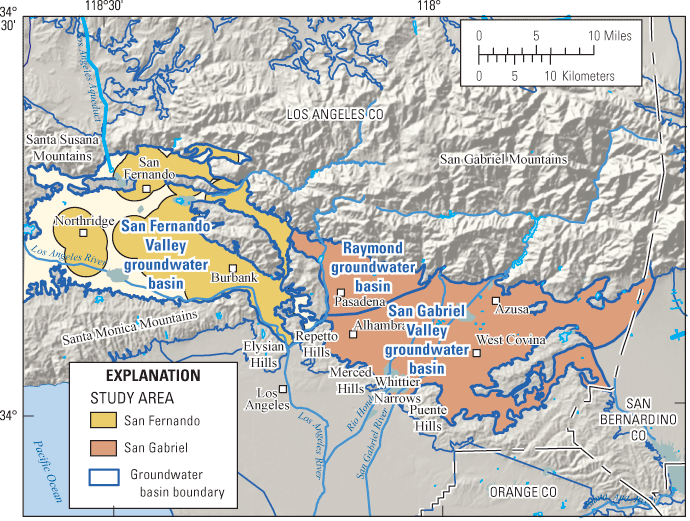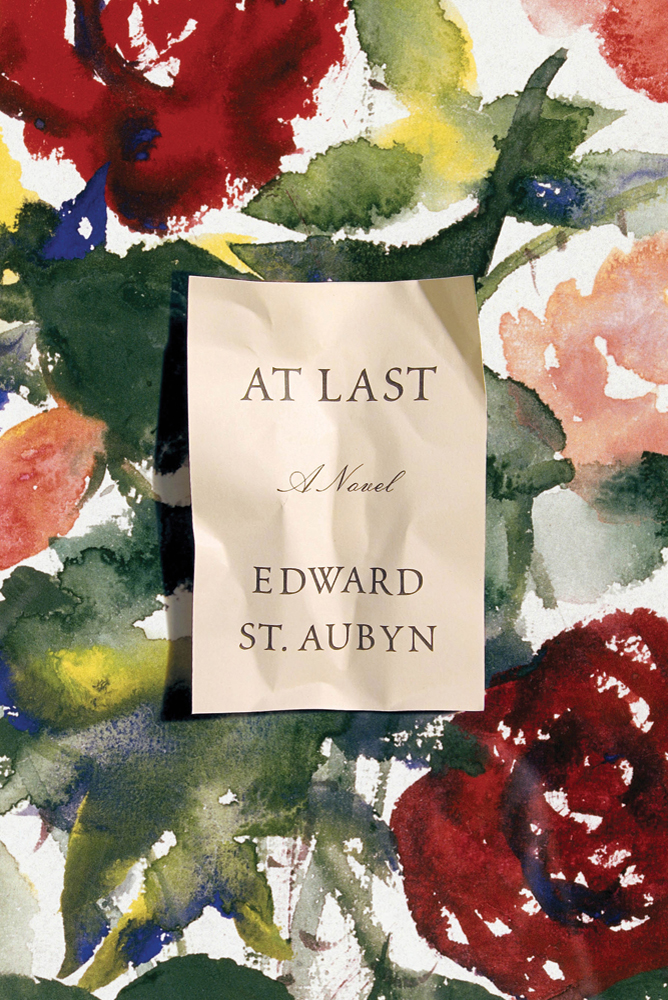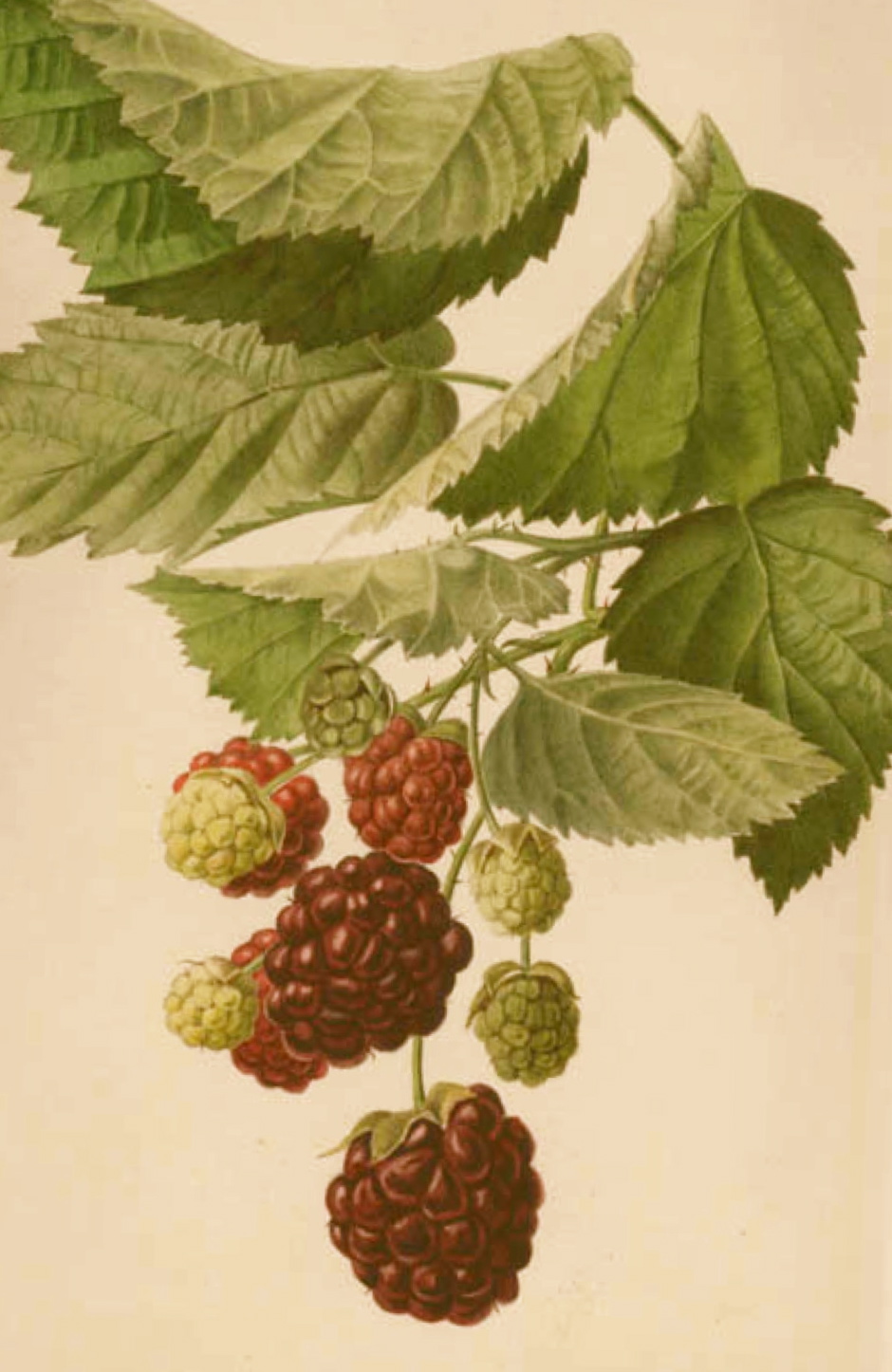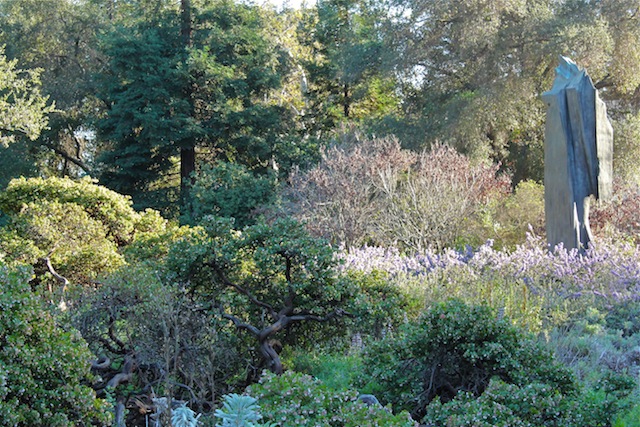Water quality beneath the asphalt
Posted on | March 25, 2012 | No Comments
 Those wondering why so much of the recent rain across Los Angeles was flushed out to the Pacific through a storm drain system instead of socked into the local aquifer will find part of a complicated answer in a fact sheet issued last week by the US Geological Survey. Run-off from the Transverse Ranges into the San Fernando and San Gabriel valleys hits land that the USGS classes as 83% urban, which means largely paved and impermeable. (For how a combination of arrogance and greed led to over-building of the Los Angeles flood plain, there is no better source than historian Jared Orsi’s “Hazardous Metropolis.”) Another limit on our ability to store mountain run-off in these valleys is groundwater pollution brought by that urbanization. The map below shows solvent hot spots.
Those wondering why so much of the recent rain across Los Angeles was flushed out to the Pacific through a storm drain system instead of socked into the local aquifer will find part of a complicated answer in a fact sheet issued last week by the US Geological Survey. Run-off from the Transverse Ranges into the San Fernando and San Gabriel valleys hits land that the USGS classes as 83% urban, which means largely paved and impermeable. (For how a combination of arrogance and greed led to over-building of the Los Angeles flood plain, there is no better source than historian Jared Orsi’s “Hazardous Metropolis.”) Another limit on our ability to store mountain run-off in these valleys is groundwater pollution brought by that urbanization. The map below shows solvent hot spots.
Hat tip to the Water Education Foundation’s Aquafornia for signalling the sheet’s publication.
Nevada State Engineer refills Vegas pipeline
Posted on | March 23, 2012 | No Comments

Click on the scoreboard to be taken to a Las Vegas Review-Journal report of yesterday's pipeline decision.
It was never supposed to be a fight. When 22 years ago Las Vegas water manager Pat Mulroy first filed claims on all the theoretically unappropriated water in five rural valleys in eastern Nevada, opponents were supposed to roll over or be crushed. In Mulroy’s corner were all the money and influence that Vegas could bring to bear. A remark reportedly made early in 2007 by Mulroy during a Las Vegas Sun editorial board meeting summed up the odds. In it, when asked what she would do if the State Engineer denied her claims, Mulroy allegedly replied that she would have the Governor of Nevada replace him.
The story may or may not be true*, however, the point is that it could be. It sounds like Pat. No one familiar with what is now newsroom legend doubted then or doubts now that her backers — among them Steve Wynn, Kirk Kerkorian, Sheldon Adelson and homebuilders such as the Sun’s proprietor Brian Greenspun — collectively had the power to do it. They not only arguably controlled Mulroy, they also controlled the Nevadan congressional delegation of both parties, including by that point US Senate majority leader Harry Reid. They controlled the state legislature. The US Department of Interior’s agencies overseeing the affected territories were so biddable that they signed off on the pumping in exchange for vague monitoring promises before the State Engineer even began hearing Vegas arguments for the water.
The only things that Las Vegas dollars didn’t control were the rural communities in the path of the proposed 300-mile-long pipeline. Click here to keep reading
Pulsing jewels: Edward St Aubyn’s ‘At Last’
Posted on | March 19, 2012 | 2 Comments

First, what a lovely painting of roses by British surgeon and artist Sir Roy Calne decorates the dust jacket of Edward St Aubyn’s new novel “At Last.”
Second, what fine filling there is between the covers.
Others have written about the desolation, wit and clawed progress toward hope that makes the final installment of St Aubyn’s “Melrose novels” proof, as if proof were needed, that high-end English ennui is not dead, not embalmed and sole territory for the period costume department of the BBC. “At Last” was so powerfully admired by New Yorker critic James Wood that his review amounted to placing an encyclopedia on a daisy. What I haven’t seen remarked on, which is not to say that it hasn’t been noticed — even all over the place, is that the core of St Aubyn’s solace in this strange and beautiful book isn’t in the wit of the characters, distilled into morbid form at a funeral. The lever that lifts the book, and seemingly the author, past revenge comedy is the landscape. When St Aubyn’s characters escape outdoors, where there is beauty to be had, his clinical eye records it, “the unopened irises, like paintbrushes dipped in blue;” the “bobbing majesty” of a pheasant’s “avian gait, the price of a strained talent.”
There are tacit rules about spoiling magnificent passages with opportune excerpts, so to keep the wreckage to a minimum, consider how this one kernel of wonder, from a childhood moment in Provence, sustains the chief narrator:
“…in the system of imaginary protection that the land used to allow him, it was the lucky tree frogs that really counted. If only he could touch one of them, everything would be all right. They were hard to find. The round suckers on the tips of their feet meant that they could hang anywhere in the tree, camouflaged by the bright green of a new leaf or an unripe fig. When he did see one of these tiny frogs, fixed to the smooth grey bark, its brilliant skin stretched over a sharp skeleton, it looked to him like pulsing jewellery. He would reach out his index finger and touch it lightly for good luck. It might have only happened once, but he had thought about it a thousand times.”
And so shall I.
Is a coda needed here about the importance of allowing children outside, alone, in unfiltered nature? Or about why we shouldn’t wreck places fit for frogs? It shouldn’t be, but it probably is, certainly here in Los Angeles, possibly even in the privileged hell captured by St Aubyn.
Rubus ursinus: A beary good berry
Posted on | March 14, 2012 | No Comments

Click on the 1924 Royal G. Steadman rendering of a youngberry (Source: USDA) to be taken to tomorrow's LA Weekly article on Rubus ursinus, the Pacific blackberry still native to rare, undeveloped pockets of Los Angeles. Its fragrance and intense flavor gave rise to the caviar of summer: boysenberries, youngberries, marionberries and loganberries. Then, if you can, plant one of these brambles, either the straight-up species or a hybrid whose native Western progenitor was named for the bears who love them. The plants are disappearing from commerce as tougher specimens from Eastern and South American stock increasingly dominate the nursery and fresh fruit trades.
How Rancho Santa Ana Botanic Garden grew, 1950-1970
Posted on | March 13, 2012 | 5 Comments
 As wild California has steadily succumbed to development during the last century, a doughty effort to conserve its native plants has been underway at the Rancho Santa Ana Botanic Garden, first at the original grounds in Santa Ana Canyon in Orange County and latterly in Claremont in Los Angeles County. This month, the Claremont garden quietly published a meticulously noted and just as meticulously translated summary of two decades of goings-on inside what amounts to a Noah’s Ark for California’s flora.
As wild California has steadily succumbed to development during the last century, a doughty effort to conserve its native plants has been underway at the Rancho Santa Ana Botanic Garden, first at the original grounds in Santa Ana Canyon in Orange County and latterly in Claremont in Los Angeles County. This month, the Claremont garden quietly published a meticulously noted and just as meticulously translated summary of two decades of goings-on inside what amounts to a Noah’s Ark for California’s flora.
As early as the 1920s, the Southland’s oak woodlands, wetlands, riparian corridors and coastal sage-scrub communities were already being destroyed at such a rate that heiress Susanna Bixby Bryant offered roughly 200 acres of her family cattle and citrus ranch in Orange County for the creation of a native plant botanic garden. The objective, recalled Rancho director Philip Munz in 1947, was collecting, growing and thus preserving “a very large percentage” of a very large state’s plants.
To establish what became the collection, Bryant employed the good and great of American botany. Among them: Munz, then a taxonomist at Pomona College; Ernest Braunton, British-born naturalist and garden editor at the Los Angeles Times from 1903-36; father of American landscape architecture Frederick Law Olmsted, Jr; Los Angeles nurseryman Theodore Payne and Berkeley botanist Willis Linn Jepson. Click here to keep reading
Tags: Bart O'Brien > chance of rain > Emily Green > Rancho Santa Ana Botanic Garden



